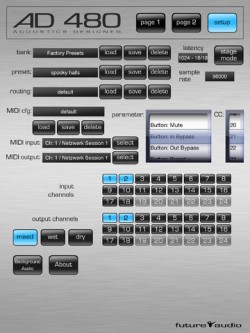 Developer Thomas Fiedler (Future Audio) has introduced AD 480 pro – described as “the first professional reverb app” for iOS.
Developer Thomas Fiedler (Future Audio) has introduced AD 480 pro – described as “the first professional reverb app” for iOS.
Features:
- Variable room size
- 108 presets
- Preset management for MIDI, audio and reverb settings
- Extensive filter layout for a wide spectrum of sound
- Supports internal and external (USB class compliant or MFi) audio interfaces
- Routing matrix, which supports up to 24 input and 24 output channels
- Full Audiobus integration (input, filter and output position)
- Supports full MIDI communication via network and USB-MIDI interfaces, as well as inter-app MIDI
- Supports sample rates of 44.1 kHz – 96 kHz
- Latencies from 64 samples
- Special low-light mode for live use on stage (“stage mode”, iPad only)
- Background audio for multitasking with other apps
Note that this app requires at least iPad 2, iPod touch 5G or iPhone 4S.
AD 480 pro is available now in the App Store. A demo version is available.
If you’ve used AD 480 pro, let us know what you think of it!

i think the ipad was ok before all these professional apps came out
24 inputs 24 outputs on a 10 inch screen – how useful is that ? i don’t even do that on my desktop
what i would really like to see is a ipad with more hardware i/o and lower cost
— but i think they call that ANDROID
Too bad the lower cost of Android tablets comes with 1/4 second of latency and crap hardware….
when they say 24 i/o, correct me if I’m wrong,
I think they mean this by plugging the same desktop class USB compliant soundcards (well, audio interfaces) with tons of i/o you may already have. Thus bypassing the ipad dac/adc that is *only* 44.1khz 16bit and maybe gaining DIN midi i/o if your interface also have them.
Horrendous lag apart, I’m not sure if stock Android can even deal with external interface and midi reliably.
Takes a hellova phone call though.
I can’t speak to it’s sound quality, but I would think a “professional” reverb could have a user interface that didn’t look like it was designed in the early 90s.